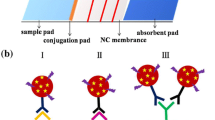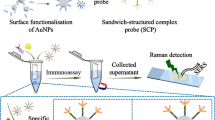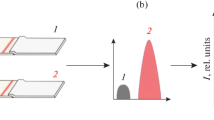Abstract
A new approach to direct quantitative detection of small molecules (haptens) by dynamic light scattering biosensing is presented. The proposed technique implements a homogeneous competitive immunoassay and is based on optical detection of specific inhibition of nanoparticle aggregation induced by the analyte in a sample. The technique performance was tested both in buffer and milk for detection of chloramphenicol – antibiotic relevant to food safety diagnostics. Good specificity, sensitivity (LOD in milk is 2.4 ng/ml), precision (4.0 ± 1.2%), ruggedness (8.3%), and 96% recovery in conjunction with a record wide dynamic range (3 orders of magnitude) of the nanosensing technique were demonstrated. Such characteristics complemented by the assay simplicity (no washing step) and a short assay time make the approach attractive for application as an analytical platform for point-of-care and field-oriented diagnostics.

Graphical abstract






Similar content being viewed by others
References
Wolfbeis OS. Optical technology until the year 2000: an historical overview. In: Optical sensors. Berlin: Springer Berlin Heidelberg; 2004. p. 1–34.
Nikitin PI, Beloglazov AA. A multi-purpose sensor based on surface plasmon polariton resonance in a Schottky structure. Sensors Actuators A Phys. 1994;42:547–52. https://doi.org/10.1016/0924-4247(94)80051-0.
Gauglitz G, Homola J. Direct optical detection. Anal Bioanal Chem. 2015;407:3881–2. https://doi.org/10.1007/s00216-015-8577-6.
Zourob M, Elwary S, Turner A. Principles of bacterial detection: biosensors, recognition receptors and microsystems. New York: Springer New York; 2008.
Du B-A, Li Z-P, Liu C-H. One-step homogeneous detection of DNA hybridization with gold nanoparticle probes by using a linear light-scattering technique. Angew Chem Int Ed. 2006;45:8022–5. https://doi.org/10.1002/anie.200603331.
Liu X, Dai Q, Austin L, Coutts J, Knowles G, Zou J, et al. A one-step homogeneous immunoassay for cancer biomarker detection using gold nanoparticle probes coupled with dynamic light scattering. J Am Chem Soc. 2008;130:2780–2. https://doi.org/10.1021/ja711298b.
Huang X, Xu Z, Mao Y, Ji Y, Xu H, Xiong Y, et al. Gold nanoparticle-based dynamic light scattering immunoassay for ultrasensitive detection of Listeria monocytogenes in lettuces. Biosens Bioelectron. 2015;66:184–90. https://doi.org/10.1016/j.bios.2014.11.016.
Dai Q, Liu X, Coutts J, Austin L, Huo Q. A one-step highly sensitive method for DNA detection using dynamic light scattering. J Am Chem Soc. 2008;130:8138–9. https://doi.org/10.1021/ja801947e.
Kalluri JR, Arbneshi T, Afrin Khan S, Neely A, Candice P, Varisli B, et al. Use of gold nanoparticles in a simple colorimetric and ultrasensitive dynamic light scattering assay: selective detection of arsenic in groundwater. Angew Chem Int Ed. 2009;48:9668–71. https://doi.org/10.1002/anie.200903958.
Borisov SM, Wolfbeis OS. Optical biosensors. Chem Rev. 2008;108:423–61. https://doi.org/10.1021/cr068105t.
Nikitin MP, Shipunova VO, Deyev SM, Nikitin PI. Biocomputing based on particle disassembly. Nat Nanotechnol. 2014;9:716–22. https://doi.org/10.1038/nnano.2014.156.
Tregubov AA, Nikitin PI, Nikitin MP. Advanced smart nanomaterials with integrated logic-gating and biocomputing: dawn of theranostic nanorobots. Chem Rev. 2018;118:10294–348. https://doi.org/10.1021/acs.chemrev.8b00198.
Sokolov IL, Cherkasov VR, Tregubov AA, Buiucli SR, Nikitin MP. Smart materials on the way to theranostic nanorobots: molecular machines and nanomotors, advanced biosensors, and intelligent vehicles for drug delivery. Biochim Biophys Acta Gen Subj. 2017;1861:1530–44. https://doi.org/10.1016/j.bbagen.2017.01.027.
Cherkasov VR, Mochalova EN, Babenyshev AV, Vasilyeva AV, Nikitin PI, Nikitin MP. Nanoparticle beacons: supersensitive smart materials with on/off-switchable affinity to biomedical targets. ACS Nano. 2020;14:1792–803. https://doi.org/10.1021/acsnano.9b07569.
Jans H, Liu X, Austin L, Maes G, Huo Q. Dynamic light scattering as a powerful tool for gold nanoparticle bioconjugation and biomolecular binding studies. Anal Chem. 2009;81:9425–32. https://doi.org/10.1021/ac901822w.
Zheng T, Bott S, Huo Q. Techniques for accurate sizing of gold nanoparticles using dynamic light scattering with particular application to chemical and biological sensing based on aggregate formation. ACS Appl Mater Interfaces. 2016;8:21585–94. https://doi.org/10.1021/acsami.6b06903.
Seow N, Tan YN, Yung L-YL. Gold nanoparticle-dynamic light scattering tandem for the rapid and quantitative detection of the let7 microRNA family. Part Part Syst Charact. 2014;31:1260–8. https://doi.org/10.1002/ppsc.201400158.
Seow N, Tan YN, Yung L-YL SX. DNA-directed assembly of nanogold dimers: a unique dynamic light scattering sensing probe for transcription factor detection. Sci Rep. 2016;5:18293. https://doi.org/10.1038/srep18293.
Li C, Ma J, Fan Q, Tao Y, Li G. Dynamic light scattering (DLS)-based immunoassay for ultra-sensitive detection of tumor marker protein. Chem Commun. 2016;52:7850–3. https://doi.org/10.1039/C6CC02633H.
Zheng T, Pierre-Pierre N, Yan X, Huo Q, Almodovar AJO, Valerio F, et al. Gold nanoparticle-enabled blood test for early stage cancer detection and risk assessment. ACS Appl Mater Interfaces. 2015;7:6819–27. https://doi.org/10.1021/acsami.5b00371.
Mustafaoglu N, Kiziltepe T, Bilgicer B. Site-specific conjugation of an antibody on a gold nanoparticle surface for one-step diagnosis of prostate specific antigen with dynamic light scattering. Nanoscale. 2017;9:8684–94. https://doi.org/10.1039/C7NR03096G.
Huo Q, Litherland SA, Sullivan S, Hallquist H, Decker DA, Rivera-Ramirez I. Developing a nanoparticle test for prostate cancer scoring. J Transl Med. 2012;10:44. https://doi.org/10.1186/1479-5876-10-44.
Driskell JD, Jones CA, Tompkins SM, Tripp RA. One-step assay for detecting influenza virus using dynamic light scattering and gold nanoparticles. Analyst. 2011;136:3083. https://doi.org/10.1039/c1an15303j.
Zheng T, Finn C, Parrett CJ, Dhume K, Hwang JH, Sidhom D, et al. A rapid blood test to determine the active status and duration of acute viral infection. ACS Infect Dis. 2017;3:866–73. https://doi.org/10.1021/acsinfecdis.7b00137.
Lai YH, Koo S, Oh SH, Driskell EA, Driskell JD. Rapid screening of antibody–antigen binding using dynamic light scattering (DLS) and gold nanoparticles. Anal Methods. 2015;7:7249–55. https://doi.org/10.1039/C5AY00674K.
Gao D, Sheng Z, Han H. An ultrasensitive method for the detection of gene fragment from transgenics using label-free gold nanoparticle probe and dynamic light scattering. Anal Chim Acta. 2011;696:1–5. https://doi.org/10.1016/j.aca.2011.04.001.
Fu C, Ma H, Huang C, Jia N. A simple and dual functional dynamic light scattering (DLS) probe for rapid detection of mercury ions and biothiols. Anal Methods. 2015;7:7455–60. https://doi.org/10.1039/C5AY01880C.
Huang X, Liu Y, Yung B, Xiong Y, Chen X. Nanotechnology-enhanced no-wash biosensors for in vitro diagnostics of cancer. ACS Nano. 2017;11:5238–92. https://doi.org/10.1021/acsnano.7b02618.
Orlov AV, Nikitin MP, Bragina VA, Znoyko SL, Zaikina MN, Ksenevich TI, et al. A new real-time method for investigation of affinity properties and binding kinetics of magnetic nanoparticles. J Magn Magn Mater. 2015;380:231–5. https://doi.org/10.1016/j.jmmm.2014.10.019.
Ivanov AE, Pushkarev AV, Orlov AV, Nikitin MP, Nikitin PI. Interferometric detection of chloramphenicol via its immunochemical recognition at polymer-coated nano-corrugated surfaces. Sensors Actuators B Chem. 2019;282:984–91. https://doi.org/10.1016/j.snb.2018.11.043.
Sai N, Chen Y, Liu N, Yu G, Su P, Feng Y, et al. A sensitive immunoassay based on direct hapten coated format and biotin–streptavidin system for the detection of chloramphenicol. Talanta. 2010;82:1113–21. https://doi.org/10.1016/j.talanta.2010.06.018.
Brox S, Ritter AP, Küster E, Reemtsma T. A quantitative HPLC–MS/MS method for studying internal concentrations and toxicokinetics of 34 polar analytes in zebrafish (Danio rerio) embryos. Anal Bioanal Chem. 2014;406:4831–40. https://doi.org/10.1007/s00216-014-7929-y.
Dams ET, Laverman P, Oyen WJ, Storm G, Scherphof GL, van Der Meer JW, et al. Accelerated blood clearance and altered biodistribution of repeated injections of sterically stabilized liposomes. J Pharmacol Exp Ther. 2000;292:1071–9.
Sun M, Ding B, Lin J, Yu J, Sun G. Three-dimensional sensing membrane functionalized quartz crystal microbalance biosensor for chloramphenicol detection in real time. Sensors Actuators B Chem. 2011;160:428–34. https://doi.org/10.1016/j.snb.2011.08.004.
Amjadi M, Jalili R, Manzoori JL. A sensitive fluorescent nanosensor for chloramphenicol based on molecularly imprinted polymer-capped CdTe quantum dots. Luminescence. 2016;31:633–9. https://doi.org/10.1002/bio.3003.
Xie Y, Zhao M, Hu Q, Cheng Y, Guo Y, Qian H, et al. Selective detection of chloramphenicol in milk based on a molecularly imprinted polymer-surface-enhanced Raman spectroscopic nanosensor. J Raman Spectrosc. 2017;48:204–10. https://doi.org/10.1002/jrs.5034.
Javidi M, Housaindokht MR, Verdian A, Razavizadeh BM. Detection of chloramphenicol using a novel apta-sensing platform based on aptamer terminal-lock in milk samples. Anal Chim Acta. 2018;1039:116–23. https://doi.org/10.1016/j.aca.2018.07.041.
Wu Y, Liu B, Huang P, Wu F-Y. A novel colorimetric aptasensor for detection of chloramphenicol based on lanthanum ion–assisted gold nanoparticle aggregation and smartphone imaging. Anal Bioanal Chem. 2019. https://doi.org/10.1007/s00216-019-02149-7.
Saha B, Evers TH, Prins MWJ. How antibody surface coverage on nanoparticles determines the activity and kinetics of antigen capturing for biosensing. Anal Chem. 2014;86:8158–66. https://doi.org/10.1021/ac501536z.
Gambinossi F, Mylon SE, Ferri JK. Aggregation kinetics and colloidal stability of functionalized nanoparticles. Adv Colloid Interf Sci. 2015;222:332–49. https://doi.org/10.1016/j.cis.2014.07.015.
Holthoff H, Egelhaaf SU, Borkovec M, Schurtenberger P, Sticher H. Coagulation rate measurements of colloidal particles by simultaneous static and dynamic light scattering. Langmuir. 1996;12:5541–9. https://doi.org/10.1021/la960326e.
Shevchenko KG, Cherkasov VR, Nikitina IL, Babenyshev AV, Nikitin MP. Smart multifunctional nanoagents for in situ monitoring of small molecules with a switchable affinity towards biomedical targets. Appl Nanosci. 2018;8:195–203. https://doi.org/10.1007/s13204-018-0659-2.
Guteneva NV, Znoyko SL, Orlov AV, Nikitin MP, Nikitin PI. Rapid lateral flow assays based on the quantification of magnetic nanoparticle labels for multiplexed immunodetection of small molecules: application to the determination of drugs of abuse. Microchim Acta. 2019;186:621. https://doi.org/10.1007/s00604-019-3726-9.
Shevchenko KG, Cherkasov VR, Tregubov AA, Nikitin PI, Nikitin MP. Surface plasmon resonance as a tool for investigation of non-covalent nanoparticle interactions in heterogeneous self-assembly & disassembly systems. Biosens Bioelectron. 2017;88:3–8. https://doi.org/10.1016/j.bios.2016.09.042.
Levin AD, Shmytkova EA. Nonspherical nanoparticles characterization by partially depolarized dynamic light scattering. Proc SPIE. 2015;9526:95260P. https://doi.org/10.1117/12.2184867.
National Center for Biotechnology Information (accessed on Mar. 12, 2020) PubChem Database. Chloramphenicol, CID=5959, https://pubchem.ncbi.nlm.nih.gov/compound/Chloramphenicol.
Funding
This multidisciplinary work was supported by the grant of Russian Science Foundation no. 16-19-00131 (development and characterization of the nanoparticles and their conjugates with bioreceptors) and Ministry of Science and Higher Education of Russian Federation in the framework of the implementation of agreement no. 14.624.21.0045 of September 26, 2017 (unique identifier RFMEFI62417X0045) (dynamic light scattering assay experiments).
Author information
Authors and Affiliations
Corresponding authors
Ethics declarations
Conflict of interest
All-Russian Research Institute for Optical and Physical Measurements has filed a patent application RU2019140681 on the developed assay technology (L.A.D., R.A., A.M.K., D.E.B., N.M.P. are named as the inventors).
Additional information
Published in the topical collection Advances in Direct Optical Detection with guest editors Antje J. Baeumner, Günter Gauglitz, and Jiri Homola.
Publisher’s note
Springer Nature remains neutral with regard to jurisdictional claims in published maps and institutional affiliations.
Electronic supplementary material
ESM 1
(PDF 609 kb)
Rights and permissions
About this article
Cite this article
Levin, A.D., Ringaci, A., Alenichev, M.K. et al. Dynamic light scattering biosensing based on analyte-induced inhibition of nanoparticle aggregation. Anal Bioanal Chem 412, 3423–3431 (2020). https://doi.org/10.1007/s00216-020-02605-9
Received:
Revised:
Accepted:
Published:
Issue Date:
DOI: https://doi.org/10.1007/s00216-020-02605-9




